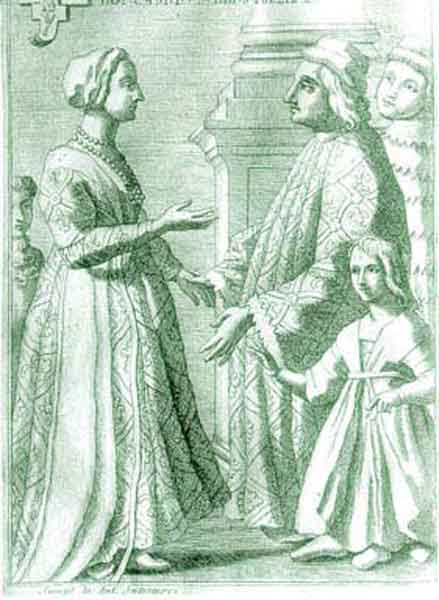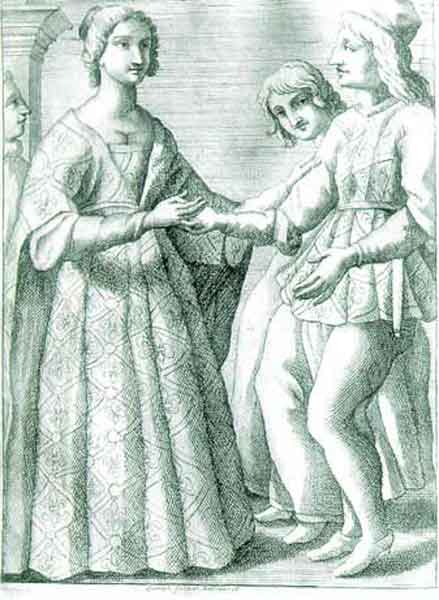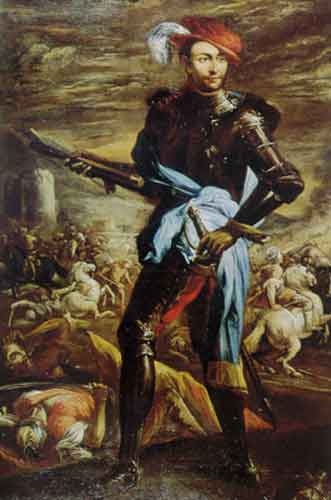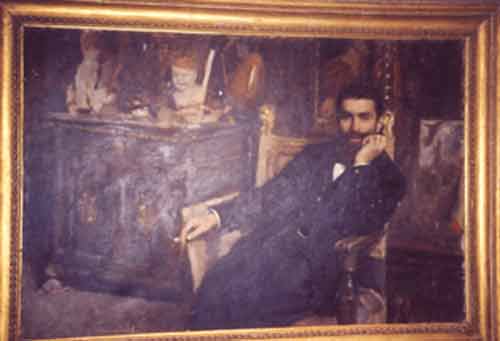| I Varano, per oltre trecento anni signori di Camerino, costruirono a difesa e controllo del loro territorio un formidabile scacchiere fortificato che si avvaleva di numerose costruzioni militari: rocche, torri e cinte fortificate. Nel 1382 Giovanni da Varano detto "Spaccaferro", per contrastare le mire espansionistiche di Matelica e San Severino, realizzò una linea difensiva che si estendeva per circa 12 chilometri, da Torre Beregna, crollata in tempi recenti, alle bocche di Pioraco. Ne facevano parte le due torri di Rocca d'Ajello, Torre del Parco (detta anche "Salvum me fac", "Torre dei Bilancioni" o "Torre del Ponte" in quanto difendeva il ponte sul fiume Potenza), il castello di Lanciano (trasformato in splendida villa con grande parco da Giovanna Malatesta, sposa di Giulio Cesare Varano, alla fine del sec. XV) e la torre Porta di Ferro a Pioraco, non più esistente. Le difese della linea erano costituite da fosse, terrapieni e da una sorta di cavalli di frisia la cui realizzazione richiedeva una grande quantità di alberi: da qui il nome di "Tagliata" o "Intagliata". Fra il 1260 e il 1280 Gentile I da Varano fece edificare le due torri di Rocca d'Ajello, il cui nome deriva forse dalla parola "Agellus" (campicello). Erano torri di avvistamento, sicuramente molto più alte di quanto non siano attualmente, da cui si effettuavano collegamenti ottici con altre fortezze dello scacchiere e si controllava il vicino fiume Potenza, la conca del Palente e la gola che conduceva a torre Beregna, detta anche "Troncapassi". Le due unità fortificate erano collegate da una galleria seminterrata ed essendo costruite a distanza ravvicinata, sottoponevano l'eventuale attaccante a tiro incrociato nell'area sorvegliata in comune. A Giovanni da Varano (1377) si deve l'inizio della trasformazione del complesso, che sarà portata a compimento nel 1475 da Giulio Cesare da Varano, le cui iniziali figurano in un frammento di affresco ritrovato nella Sala d'Armi. Le due torri vennero collegate per mezzo di una cortina a piombo, in modo che aggettassero ai vertici di due lati, diagonalmente, infilando ciascuna due fronti. Questa integrazione strutturale ha dato vita ad un complesso fortificato a pianta trapezoidale, adibito anche ad abitazione. Nell'inventario dei beni dei Varano fatto redigere nel 1502 da Cesare Borgia, impadronitosi dello stato di Camerino, Ajello è definito "Villa con Rocca". Dopo la fine della signoria dei Varano, a metà del '500, il castello passò allo Stato della Chiesa e quindi a varie famiglie fra cui i Massei e i Bruschetti. Nella seconda metà dell'Ottocento fu acquistato da Ortenzio Vitalini, ai cui discendenti tuttora appartiene. L'attuale aspetto della costruzione è frutto di una serie di trasformazioni dovute soprattutto ai crolli causati dai terremoti, fra cui quello disastroso a fine '700. L'antica struttura della fortezza è tuttora ben visibile ai livelli più bassi. La cantina, un vasto ambiente dalla volta a botte, mostra sul fondo gli strati di roccia su cui poggia la costruzione. All'epoca dei Varano, era la scuderia della guarnigione: tutto un lato è occupato da una serie di nicchie che servivano da mangiatoie per i cavalli. Era questo sicuramente il passaggio seminterrato che collegava le due torri. Ancora più in basso troviamo una serie di cellette scavate in parte nella roccia e sormontate da piccole volte a crociera, adibite anticamente a celle per i prigionieri, e in seguito usate per mantenere in fresco cibi e vino. Attraverso un grottone con volta a botte, si passa al livello superiore, la grande Sala d'Armi, ove sono stati ritrovati pezzi di affreschi quattrocenteschi con decorazioni geometriche. Anche qui volta a botte in pietra arenaria e muri di grande spessore, a prova d'arma da fuoco. A questo livello si trova pure la cisterna per la raccolta delle acque piovane dai tetti, scavata nella roccia e collegata ad un pozzo tuttora visibile nella cucina del primo piano. Notevole il cortile con pozzo centrale, su cui si apre la porta originaria del castello, un tempo tutelata da ponte levatoio. Le stanze del primo piano e della torre principale, dalle volte affrescate fra il '700 e l'800, ospitano opere di Francesco Vitalini, pittore e incisore, nato a Fiordimonte nel 1865 e autore di un trattato sulle varie tecniche di incisione (L'incisione su metallo, Roma, 1904). Soggetti preferiti dei suoi acquerelli, quadri a olio e delle raffinate incisioni, sono Roma e la campagna romana, le colline marchigiane, il Bosforo e i Balcani, meta dei suoi viaggi, i paesaggi alpini. Proprio nelle Dolomiti trovò tragica morte nel 1905, a soli quarant'anni, cadendo nel burrone di Gravasecca vicino ad Auronzo, al ritorno da un'ascensione solitaria. La chiesa di San Biagio, antistante il castello, sorge sui resti di un'abbazia del IX secolo, dipendente dall'abbazia di Sassovivo a Foligno. L'affresco absidale, datato 1523, è opera di un pittore della scuola di Girolamo di Giovanni. Vi sono rappresentati, ai piedi del Cristo Crocifisso, Maria, Giovanni e il Vescovo San Biagio. |
| Storia della Rocca d'Ajello - History of Rocca d'Ajello's castle |
| The Varano family, the lords of Camerino for more than three hundred years, constructed a formidable fortified zone for the defence and control of their territory. This was composed of a number of military structures: fortresses, towers and fortifications. In 1382, in order to resist the expansionist intentions of Matelica and San Severino, Giovanni da Varano (known as the Iron Splitter) constructed a defence line which extended for some 12 kilometres, from Torre Beregna, a tower which has recently collapsed, to the mouth of the Pioraco Gap.
These defences included the two towers of Rocca d’Ajello, Torre del Parco (also known as “Salvum me fac”, “Torre dei Bilancioni” or “Torre del Ponte” in so far as it defended the bridge over the River Potenza), Lanciano castle (transformed into a splendid villa with a large park by Giovanna Malatesta at the end of the XV century) and the tower Porta di Ferro (Iron Gate) which guarded Pioraco (but today no longer exists). The defence line was composed of ditches, ramparts, and a sort of “cheval-de-frise” - a row of spikes fixed an top of a wall used to obstruct the passage of cavalry. In order to make this, a large number of trees needed to be felled, resulting in the term “Taghata” or “Intagliata” (cut-out). Between 1260 and 1280, Gentile I da Varano commissioned the building of the two towers of the Rocca d’Ajello, the name being derived perhaps from “agellum” (little field). The towers were certainly much higher than at present. The watchtowers formed a visual link with other defence structures of the zone. These included: Torre Beregna, Torre del Parco, Lanciano, Castelraimondo, Gagliole and they served, above all, to exercise control over the nearby River Potenza. The two fortified units were linked by a basement tunnel. Since the towers were built at a close distance from each other, an attacker could be caught in the crossfire within the area under joint surveillance. It was Giovanni da Varano (1377) who began the transformation of the complex. The work was completed in 1475 by Giulio Cesare Da Varano. His initials can be seen in a fragment of fresco which has been uncovered in the Armoury (Sala d’Armi). The two towers were also linked by a wall with battlements, thus forming a trapezoid-shaped fortified complex which is also suited to habitation. In the inventory of the assets of the Varano family, commissioned in 1502 by Cesare Borgia who had seized the State of Camerino, Ajello is defined as “Fortified Villa”. By the end of the 16th century all the Varanos were killed or exiled and their possessions including the castle became part of the Papal States and thereby were leased to different families including the Massei and the Bruschetti. In the middle of the 19th century, it was acquired by Ortenzio Vitalini. His descendants are the present owners. The structure seen today is the result of a series of transformations which are mainly the consequence of earthquake damage, particularly of the severe earthquake at the end of the 18th century. The antique structure of the fortress is visible only at the lowest levels. The cellar, a vast room with circular vaults, was where the troops stabled their horses in the days of the Varanos. All along one side, there are the niches which held feeding boxes for the horses. This was, without doubt, the underground passage that connected the two towers. At an even lower level, there are a series of cells surmounted by small cross vaults. In old times these served as prison cells and later on as cold storage for food and wine. Through a large room with a circular sandstone vault and sandstone paving, you reach the next level, the spacious Armoury where fragments of frescoes with geometric patterns, dating from the fifteenth century, have been found. Here, too, the vaults are circular and made of sandstone. The walls were built very deep, as a defence against firearms. At this level, there is also an enormous cistern dug into the rock which stored rainwater channelled from the roofs. This is linked to a well which can still be seen in the kitchen on the first floor. Particularly noteworthy is the courtyard with the well in the centre. This courtyard used to be accessed from the original gate of the castle which was then guarded by a drawbridge. The rooms of the first floor and main tower, decorated with frescoes between 18th and 19th centuries, contain the works of Francesco Vitalini, painter and engraver, born at Fiordimonte in 1865. He was the author of a treatise on the various engraving techniques (“L’incisione su metallo”, Rome, 1904). The preferred subjects of his watercolours, oil paintings and exquisite coloured engravings are Rome and the Roman countryside, the rolling hills of the Marche, the Bosphorus and the Balcans, which he visited on his travels, and Alpine landscapes. It was, in fact, in the Dolomites that he met his tragic death in 1905. At only 40 vears of age he fell into a ravine at Gravasecca, near Auronzo, when he was returning from a solo climb. The church of San Biagio, in front of the castle, was built on the remains of an abbey founded in the ninth century. The fresco in the apse is dated 1523 and belongs to the school of Girolamo di Giovanni. |
| _____________________________________________________________________________________________________ |

















